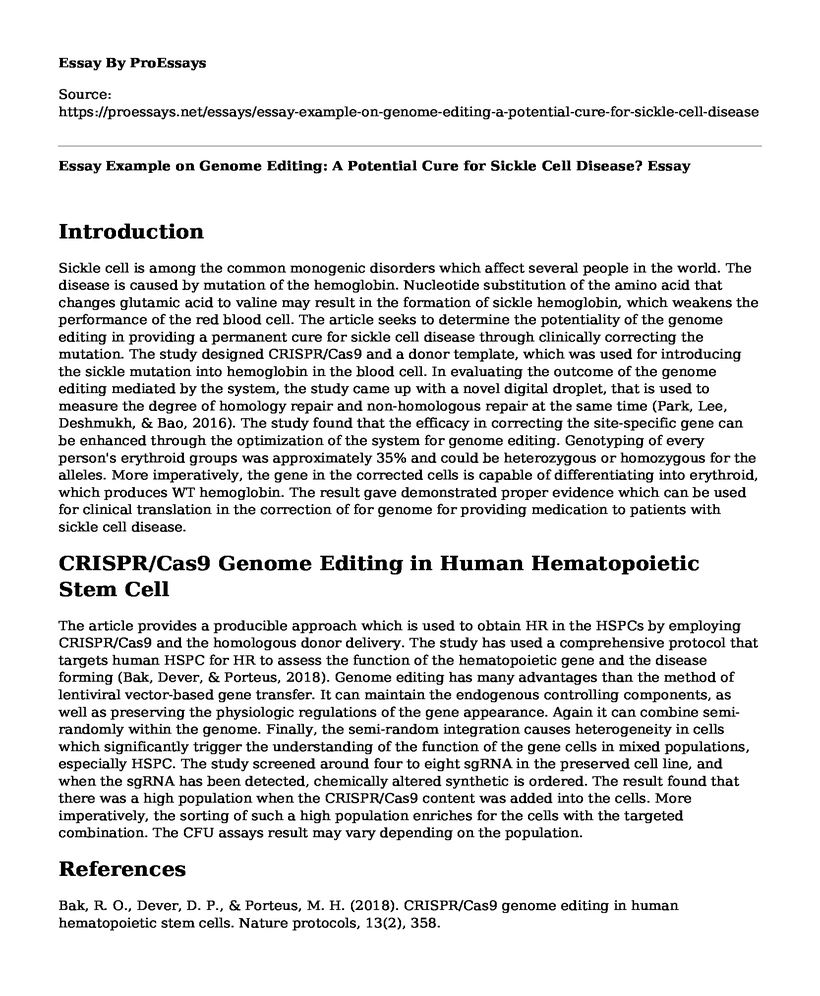Introduction
Sickle cell is among the common monogenic disorders which affect several people in the world. The disease is caused by mutation of the hemoglobin. Nucleotide substitution of the amino acid that changes glutamic acid to valine may result in the formation of sickle hemoglobin, which weakens the performance of the red blood cell. The article seeks to determine the potentiality of the genome editing in providing a permanent cure for sickle cell disease through clinically correcting the mutation. The study designed CRISPR/Cas9 and a donor template, which was used for introducing the sickle mutation into hemoglobin in the blood cell. In evaluating the outcome of the genome editing mediated by the system, the study came up with a novel digital droplet, that is used to measure the degree of homology repair and non-homologous repair at the same time (Park, Lee, Deshmukh, & Bao, 2016). The study found that the efficacy in correcting the site-specific gene can be enhanced through the optimization of the system for genome editing. Genotyping of every person's erythroid groups was approximately 35% and could be heterozygous or homozygous for the alleles. More imperatively, the gene in the corrected cells is capable of differentiating into erythroid, which produces WT hemoglobin. The result gave demonstrated proper evidence which can be used for clinical translation in the correction of for genome for providing medication to patients with sickle cell disease.
CRISPR/Cas9 Genome Editing in Human Hematopoietic Stem Cell
The article provides a producible approach which is used to obtain HR in the HSPCs by employing CRISPR/Cas9 and the homologous donor delivery. The study has used a comprehensive protocol that targets human HSPC for HR to assess the function of the hematopoietic gene and the disease forming (Bak, Dever, & Porteus, 2018). Genome editing has many advantages than the method of lentiviral vector-based gene transfer. It can maintain the endogenous controlling components, as well as preserving the physiologic regulations of the gene appearance. Again it can combine semi-randomly within the genome. Finally, the semi-random integration causes heterogeneity in cells which significantly trigger the understanding of the function of the gene cells in mixed populations, especially HSPC. The study screened around four to eight sgRNA in the preserved cell line, and when the sgRNA has been detected, chemically altered synthetic is ordered. The result found that there was a high population when the CRISPR/Cas9 content was added into the cells. More imperatively, the sorting of such a high population enriches for the cells with the targeted combination. The CFU assays result may vary depending on the population.
References
Bak, R. O., Dever, D. P., & Porteus, M. H. (2018). CRISPR/Cas9 genome editing in human hematopoietic stem cells. Nature protocols, 13(2), 358.
Park, S. H., Lee, C. M., Deshmukh, H., & Bao, G. (2016). Therapeutic Crispr/Cas9 genome editing for treating sickle cell disease.
Cite this page
Essay Example on Genome Editing: A Potential Cure for Sickle Cell Disease?. (2023, Feb 27). Retrieved from https://proessays.net/essays/essay-example-on-genome-editing-a-potential-cure-for-sickle-cell-disease
If you are the original author of this essay and no longer wish to have it published on the ProEssays website, please click below to request its removal:
- Essay Sample on Anatomic Planes in the Body of a Human Being
- Safety of Genetically Engineered Food Crops - Research Paper
- Our Moral Obligation to Future Generations in Reigning in Global Warming and its Negative Effects
- Children Nerves System
- Exploring the Grand Canyon: Nature's Deepest Gorge - Essay Sample
- Cruelty to Animals: The Mental Impact it Causes - Research Paper
- Melting Point: Key to Substance Purity & Identification - Paper Sample







